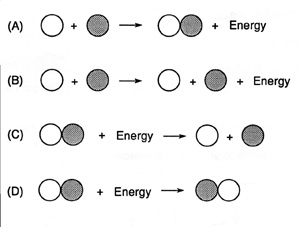Key Concepts: Chemical vs Physical Changes;
Elements vs. Compounds
Sample Questions:
1.(JUNE1995 416/36): In the
laboratory, you are to determine if a substance is a compound. After heating
the substance in an open container, you observe that a chemical reaction
is occurring and that the substance is undergoing certain changes.
Which of the following changes would definitely
indicate that the substance was a compound before it was heated?
- Its colour changes
- Its physical state changes.
- Its mass decreases.
- Its texture changes.
2.(JUNE1995 416/36): Which of the following
illustrates the formation of a compound from its elements? 
3.(JANUARY 1995 416): The state of four substances
before and after having been heated in the laboratory is presented below:
|
Substance |
Before Heating |
After Heating |
|
1 |
Dark grey solid |
Purple gas |
|
2 |
White solid |
Colourless liquid |
|
3 |
Red solid |
Gray liquid and colourless gas |
|
4 |
Brown liquid |
Orange-brown gas |
Which substance was a compound
before heating?
- 1
- 2
- 3
- 4
4.(JUNE 2000 416) Which one of the following phenomena is the result of a
physical change?
- Milk left on the counter turns sour.
- A hammer left outside rusts.
- A forest fire burns out of control.
- A pond freezes over.
Notes:
Classification
of Matter
Solutions:
homogeneous mixtures Pure Substances:
contain only one kind of substance

Elements:
contain only one kind of atom. The chemical symbol only has one capital
letter Compounds:
contain two or more elements bonded together chemically. The chemical
formula contains two or more capital letters
Examples

Solutions:
homogeneous mixtures: air, salt water, gold ring Pure Substances:
sugar(C12H22O11), water(H2O), CO2, O2,
aluminum(Al), gold(Au), sulfur(S)
Elements: O2,
aluminum(Al), gold(Au), sulfur(S) Compounds:
sugar(C12H22O11), water (H2O),
CO2,
Just what is the difference between a compound and an element? There are over 114 known elements: they are listed in the periodic table, and they make up all matter in the universe: rocks, stars, dust and living beings. Each element is made up of only one kind of atom, meaning that each atom has a specific number of protons.
As mentioned, elements have to react chemically to form compounds. As atoms bond, energy is either released or absorbed. The reverse can also take place. When a compound decomposes, we often see its two components released, and if one of them is a gas, the leftover solid or liquid will weigh less than the original solid or liquid that decomposed.
Example: 2HgO(s)--> 2Hg(s) + O2(g)
432 g --> 400 g + 32g
Also the original solid (HgO) and the product (Hg) are not the same colour. HgO is red and Hg is shiny and silvery. We have gas escaping (as suggested by the loss in solid mass: 432 vs. 400g) and a solid that is different from the original (difference in colour); the combination of these two observations suggest a chemical change.
If we had iodine going from a shiny solid to a purple gas, we would again observe an apparent loss in solid mass, but the solid left behind would not be of a different colour. Also in this physical change(sublimation) the iodine gas would turn back into shiny iodine crystals upon cooling. In the chemical reaction involving HgO, the oxygen gas escaping would not turn back into red HgO powder.
A chemical change breaks the bonds of compounds and turns them into different compounds and/or elements. Or, a chemical change may combine elements into compounds. The products of chemical reactions behave differently from the original reactants. Chemical changes in everyday life include burning, rusting, paint drying(because it combines with oxygen and actually gains weight) souring of milk, and digestion of food.
A physical change rearranges the same atoms or molecules. When ice melts, H2O molecules break up their hexagonal pattern and start to roll around, but still as H2O molecules. Whether you add a piece of sodium to ice or liquid water, you still get hydrogen gas released. Both ice and water behave in the same way towards other substances. All changes of state (melting, freezing, sublimation (solid to gas), evaporation and condensation are physical changes. So is sawing wood or tearing a piece of paper.
A physical property describes a substance in the absence of chemical change. It is related to its appearance and not its behaviour. Physical properties include density (= mass / volume), melting point, boiling point, and specific heat ( how much heat it takes to raise the temperature of 1 g of a substance by 1oC).
A chemical property describes how a substance behaves in the presence of another substance, more specifically how it reacts with other elements or compounds. Examples include:
- Sodium causes a fire when added to water
- Sulfur reacts when mixed with saltpetre and charcoal (reaction of gunpowder)
- Protein breaks down when mixed with stomach acid.
Analogy: Chemical and Physical Properties in People:
|
Personal Characteristic |
Property Type |
|
Joe wears red sandals. |
physical |
|
Joe combed his hair differently. |
physical |
|
Joe gets an ulcer when he doesn't get enough physical science homework. |
chemical |
|
Joe learns a lot when his classmates are serious. |
chemical |
|
Joe caught chicken pox from his kid sister Joe Anne. |
chemical |